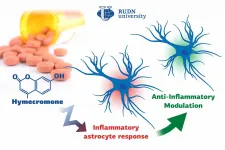Biologists from RUDN University suggested a new substance to suppress neuroinflammation
2021-02-26
(Press-News.org) Biologists from RUDN University confirmed that a well-known spasmolytic drug called hymecromone can suppress the inflammatory response in astrocytes, important glial cells of the central nervous system. Potentially, it could be used to develop medications against Alzheimer's disease and other neurodegenerative conditions. The results of the study were published in the International Journal of Molecular Sciences.
All pathological processes in the nervous system, such as neurodegenerative diseases, injuries, or intoxications, are associated with inflammations. It is due to the reaction of many auxiliary cells, including astrocytes that support the neural activity in the brain. When inflamed, astrocytes produce many antiinflammatory molecules (cytokines, interleukins, and oxylipins) that aggravate and speed up the inflammatory process. Neuroinflammation almost always results in the death of nerve cells. A team of biologists from RUDN University together with their colleagues from Lomonosov Moscow State University confirmed that the intensity of inflammation can be brought down by limiting the number of anti-inflammatory molecules produced by astrocytes. To do so, they suggested using hymecromone, a drug that is currently used to treat spasms.
"Astrocytes can synthesize hyaluronic acid, one of the main components of the brain's extracellular matrix. Our studies demonstrated that when hyaluronic acid is added to the astrocytes, it affects the production of the main anti-inflammatory molecules. In this work, we tested hymecromone that suppresses the synthesis of hyaluronic acid and measured its effect on the inflammatory response of astrocytes," said Dmitry Chistyakov, PhD, a senior researcher at the Center for Collective Use (Research and Education Center) at RUDN University, and a researcher at Lomonosov Moscow State University.
The team studied the effect of hymecromone on astrocytes in a rat brain cell culture. Cell culture samples were treated with a liposaccharide that activated the receptors in charge of the inflammation, and then with hymecromone. In order to assess the efficiency of the drug, the team extracted RNA from astrocytes and measured the activity of the genes that regulate the production of the anti-inflammatory molecules. The levels of hyaluronic acid and cytokines were measured in cell supernatants. The changes in the synthesis of signal lipids (oxylipins) were evaluated using the methods of high-efficiency liquid chromatography and tandem mass spectrometry.
Hymecromone turned out to suppress the production of anti-inflammatory molecules: tumor necrosis factor α and interleukins IL-6 and IL-1β, as well as oxylipins. At the same time, it increased the development of IL-10 that helps stop the inflammation. Having measured the levels of hyaluronic acid, the team confirmed that astrocytes actively produced this substance in response to liposaccharides. However, when a cell culture at the initial stages of the immune response was treated with hymecromone, the levels of hyaluronic acid dropped down. At the same time, hymecromone failed to have the same effect on the cells that did not inflame after contact with the liposaccharide. In these cultures, astrocytes continued to produce hyaluronic acid in regular quantities.
According to the biologists, it is still early to say for sure that the anti-inflammatory properties of hymecromone are rooted in its ability to reduce the production of hyaluronic acid. Still, the team is positive that these processes are connected.
"We managed to confirm that hymecromone is a promising compound that can be used to treat neuroinflammation. The mechanisms of its anti-inflammatory activity require further studies but given that this drug is widely used in clinical practice, the possibilities of such research are vast. Its efficiency can be safely tested when treating many pathologies that require inflammatory response suppression," added Dmitry Chistyakov from RUDN University.
INFORMATION:
[Attachments] See images for this press release:

ELSE PRESS RELEASES FROM THIS DATE:
2021-02-26
An insecticide used to control pest infestations on squash and pumpkins significantly hinders the reproduction of ground-nesting bees -- valuable pollinators for many food crops, a new University of Guelph study has revealed.
This first-ever study of pesticide impacts on a ground-nesting bee in a real-world context found female hoary squash bees exposed to imidacloprid dug 85 per cent fewer nests, collected less pollen from crop flowers and produced 89 per cent fewer offspring than unexposed bees.
"Because they're not making nests and not collecting pollen, they cannot raise offspring," said Dr. Susan Willis Chan, a post-doc in the School of ...
2021-02-26
Heart problems cause disturbed gene activity in the brain's memory center, from which cognitive deficits arise. Researchers at the German Center for Neurodegenerative Diseases (DZNE), the University Medical Center Göttingen (UMG) and the German Center for Cardiovascular Research (DZHK) come to this conclusion based on laboratory studies. They consider that they have found a possible cause for the increased risk of dementia in people with heart problems. In mice, a specific drug which is known to affect gene activity alleviated the mental deficits. The involved experts see these results as potential approaches for therapies. ...
2021-02-26
HOUSTON - (Feb. 26, 2021) - Tracking the origin of synthetic genetic code has never been simple, but it can be done through bioinformatic or, increasingly, deep learning computational approaches.
Though the latter gets the lion's share of attention, new research by computer scientist Todd Treangen of Rice University's Brown School of Engineering is focused on whether sequence alignment and pan-genome-based methods can outperform recent deep learning approaches in this area.
"This is, in a sense, against the grain given that deep learning approaches have recently outperformed traditional approaches, such as BLAST," he said. "My goal with this study is to start a conversation about how to combine the expertise of both domains to achieve further improvements for this important computational ...
2021-02-26
TORONTO, Feb. 26, 2021 - The maternal care of offspring is one of the behavioural drivers that has led some bee species to have an ever-expanding social life over the history of evolution, new research out of York University has found.
By virtue of being in a social group, the genome itself may respond by selecting more social rather than non-social genes. The behaviour and social environment come first, setting the stage for future molecular evolution.
In addition, the researchers have found that a similar genetic evolution happened independently in different species at different times, suggesting there is a unifying principle leading to the same social trait.
"There seems to be something about sociality specifically that is driving the genome to evolve in this way. It's a very ...
2021-02-26
COLUMBIA, Mo. -- Marilyn Rantz still remembers the day she got the call that her mother, whose health had been declining, had fallen and fractured her shoulder. After rushing to the hospital, her mother told her she didn't understand how she ended up on a helicopter pad after the traumatic incident. A nearby nurse told Rantz the noise from the MRI scanning tube had caused her frightened mother to mistakenly believe she had been airlifted to the hospital on a helicopter.
Determined to prevent avoidable hospitalizations, as well as the stress and panic that often comes along with the ambulance ride, Rantz, ...
2021-02-26
MEMPHIS, Tenn. - Extremely low birth weight (ELBW) infants with moderate to large patent ductus arteriosus (PDA) may benefit from transcatheter PDA closure (TCPC) in the first four weeks of life, according to research published by Le Bonheur Cardiologist Ranjit Philip, MD, and Medical Director of Interventional Cardiac Imaging and Interventional Catheterization Laboratory Shyam Sathanandam, MD. Early PDA closure may prevent early onset pulmonary vascular disease, promote growth and facilitate faster weaning off supplemental oxygen and ventilator support.
"The primary objective of this study was to describe changes in hemodynamics, ...
2021-02-26
The National Cancer Institute's Genomic Data Commons (GDC), launched in 2016 by then-Vice President Joseph Biden and hosted at the University of Chicago, has become one of the largest and most widely used resources in cancer genomics, with more than 3.3 petabytes of data from more than 65 projects and over 84,000 anonymized patient cases, serving more than 50,000 unique users each month.
In new papers published Feb. 22 in Nature Communications and Nature Genetics, the UChicago-based research team shares new details about the GDC, which is funded by the National Cancer Institute (NCI), via subcontract with the Frederick National Laboratory for Cancer Research, currently operated by ...
2021-02-26
Climate alone is not a driver for human behavior. The choices that people make in the face of changing conditions take place in a larger human context. And studies that combine insights from archaeologists and environmental scientists can offer more nuanced lessons about how people have responded -- sometimes successfully -- to long-term environmental changes.
One such study, from researchers at Washington University in St. Louis and the Chinese Academy of Sciences, shows that aridification in the central plains of China during the early Bronze Age did not cause population collapse, a result that highlights the importance of social ...
2021-02-26
URBANA, Ill. - Economists and urban planners generally agree that local pollution sources disproportionally impact racial minorities in the U.S. The reasons for this are largely unclear, but a University of Illinois study provides new insights into the issue.
"Our work finds experimental evidence that racial discrimination in the home-renting process actively sorts minority renters into neighborhoods with higher levels of pollution," says Peter Christensen, assistant professor in the Department of Agricultural and Consumer Economics (ACE) and an affiliate in Center for the Economics of Sustainability at University of Illinois.
Christensen and co-authors Ignacio Sarmiento-Barbieri, U of I, and Christopher Timmins of Duke University conducted an empirical ...
2021-02-26
Challenging the idea that older people with shorter life expectancies should rank lower in coronavirus immunization efforts, new UC Berkeley research shows that giving vaccine priority to those most at risk of dying from COVID-19 will save the maximum number of lives, and their potential or future years of life.
The findings, published Feb. 25 in the journal Proceedings of the National Academy of Sciences, address the ethical dilemma of who should be first in line for a limited supply of vaccine shots amid a contagion that so far has killed 500,000 in the United States and 2.4 million globally.
"Since older age is accompanied by falling life expectancy, it is widely assumed that means we're saving fewer years of life," said study lead author Joshua Goldstein, a UC Berkeley ...
LAST 30 PRESS RELEASES:
[Press-News.org] Biologists from RUDN University suggested a new substance to suppress neuroinflammation




